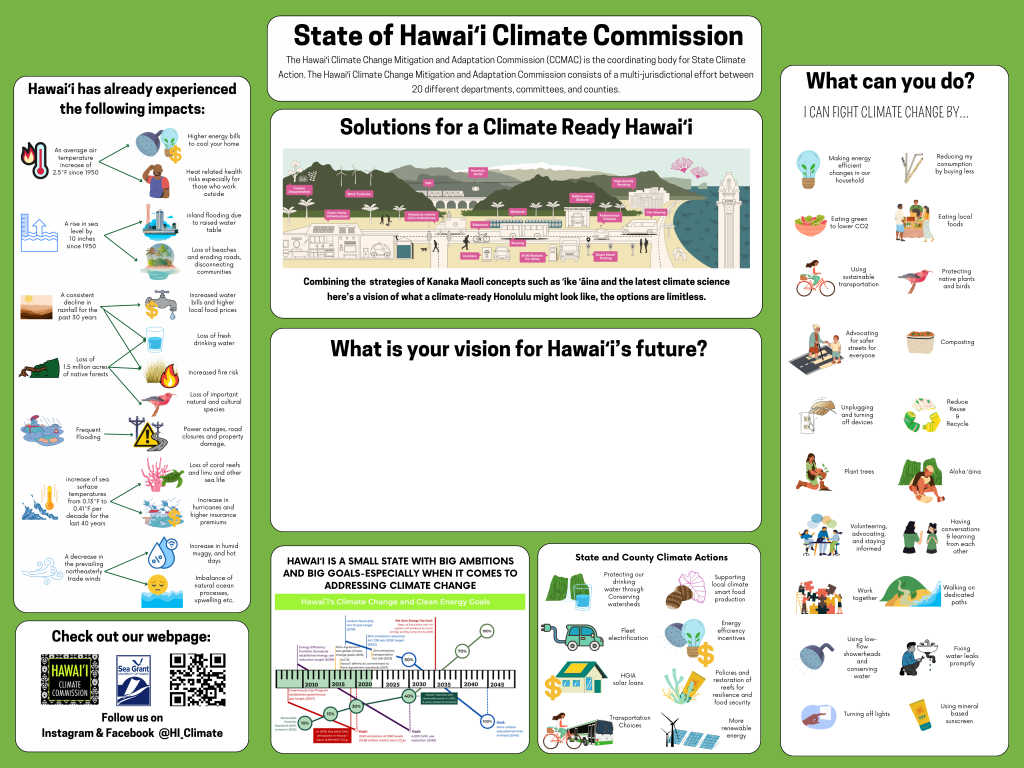- Home
- Critical Decade
- HI Climate Action
- HI Commission
- HI Resources
- HI Equity
- HI Events
HI Mitigation
Climate Action PathwayS
A community focused detailed action plan identifying steps needed to create a safe affordable and resilient climate ready Hawaiʻi
Developed in partnership with community members, State agencies, counties, technical experts, the University of Hawaiʻi system, and non-governmental organizations across Hawaiʻi the CAP is a guide for investment in policies, practices, and technologies that reduce pollutant emissions, increase affordability, enhance resiliency and safety, protect public health, create high-quality jobs, spur economic growth, and enhance the quality of life for all residents in Hawaiʻi.
Timeline

CLIMATE ACTION PATHWAYS (CAP)

Mitigation Strategies
The State of Hawaiʻi will build on existing State and County climate mitigation strategies in creating and implementing its PCAP and CAP. These strategies will combine Kanaka Maoli concepts such as ʻike ʻāina and the latest climate science. Potential mitigation strategies to reduce the Stateʻs contribution to climate change are detailed below.
Designing communities where you can get from home to work, school, the market, or other daily necessities by walking or rolling. In addition to improving public health, this reduces vehicle pollution, conserves natural resources and lowers infrastructure costs.
Planning transportation networks where people can access necessities without needing a car through walking, biking, or riding public transportation. The transportation sector accounts for 57% of Hawaiʻi’s energy use, and the production and importation of vehicles and road infrastructure produces even more emissions.
Hawaiʻi’s native forests, wetlands, grasslands, coasts, and oceans play an important role in sequestering carbon, preventing erosion, maintaining biodiversity, and broader ecosystem health. Encroachment by humans and invasive species threaten flora and fauna many of which are found nowhere else in the world.
Electric vehicles help reduce overall consumption of petroleum-based fuel by not using gasoline, particularly when the electric grid used to charge them uses renewable resources. Hawaiʻi has set a goal of 100% electric sales of all medium and heavy duty vehicles.
Renewable energy sources are constantly replenished by the earth, and green energy emits low amounts of carbon emissions. Hawaiʻi has set a goal of 100% of electricity being generated by green renewable sources by 2050; as of 2022 about a third of our electricity is from green renewable energy, the most common of which is solar.
A circular economy changes the way that resources are extracted, used, and disposed to minimize negative externalities (like pollution) and waste through processes such as designing for long-term use, recycling, and waste-management. The ahupuaʻa system shares many aspects with circular economics, and also shares a view of the economy as an ecosystem rather than a tool to maximize production.
Nature based solutions apply processes found in nature to the built/”man-made” environment to promote climate resiliency and promote other environmental and economic benefits. Examples include growing native coastal plants along shorelines to protect coastal property and reduce beach erosion.
Energy efficiency refers to maximizing energy output relative to input, meaning less energy is needed to get the same amount of work done. Hawai‘i has set a goal of reducing electricity consumption by 4,300 Gwh by 2030 through measures such as building retrofits, construction policies, energy saving technologies, and energy saving practices.
Regenerative agriculture uses food production practices that promote soil and environmental health through growing context-specific crops, improving soil health, and reducing the need for high-emission industrial fertilizer inputs. Regenerative agriculture is a core component of a circular economy, and a part of the ahupuaʻa
system.
The disposal of goods generates greenhouse gas emissions through their transportation and storage, and also equals the end of the useful life of goods produced with carbon emissions. Hawai‘i’s has set a goal of reducing solid waste by 70% by 2030 through reduced consumption, recycling, bioconversion, and landfill diversion.
Energy incentives are financial and economic tools to offset the potential higher upfront market price that may work against the adoption of green energy sources and energy-efficient technologies and equipment. These may include cash rebates, tax credits, below-market loans, and are offered by the State of Hawaiʻi, US Federal Government, Hawaiian Electric, and Hawaiʻi Energy among others.



